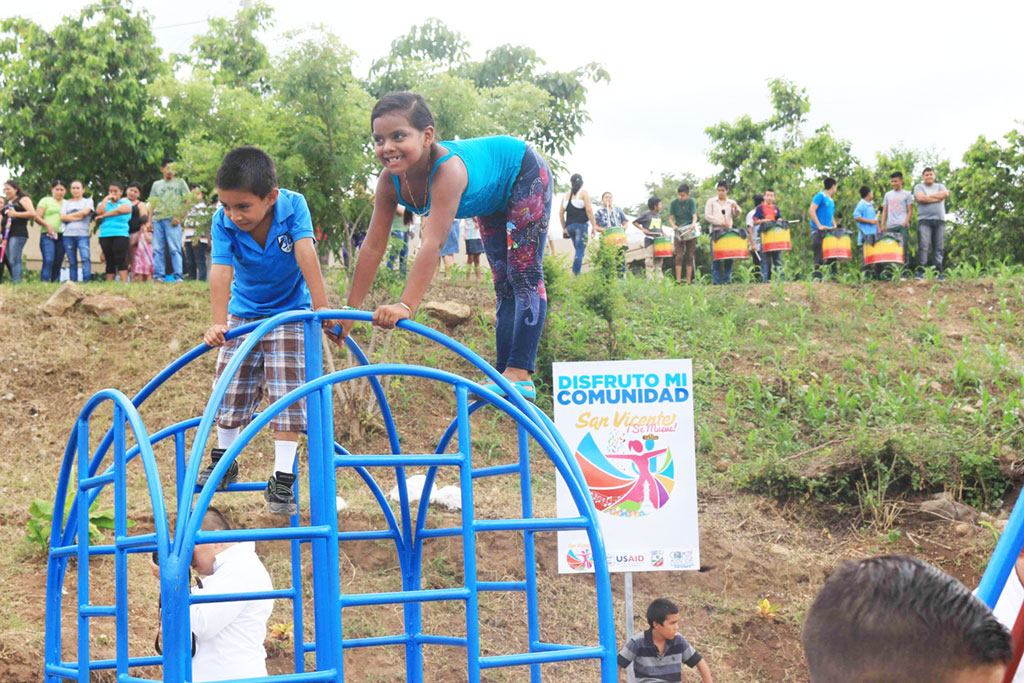On the outskirts of San Vicente, El Salvador, a construction crew was putting the final touches on a new playground that will feature swings, a slide, a merry go round and benches.
A municipal official from this town of 53,000 people says the playground is of particular importance for residents in this area.
“There are gangs about 50 meters in that direction,” he says, pointing at a cluster of houses on the other side of a small patch of wooded area. “There are more gang members over there,” he says, pointing in the opposite direction.
Sadly, he comments, a group of gang members were killed in this area about a year ago.
Located about an hour from the capital of San Salvador, this community hopes to turn this situation around with playgrounds, street lights, sidewalks and other community-focused tactics. In particular, this playground is an initiative designed to provide safe, open spaces for families and to help reduce crime and violence. It has worked elsewhere in this city.
San Vicente is an active participant in the El Salvador Crime and Violence Prevention Project, a five-year, $24 million project funded by the U.S. Agency for International Development and implemented by Creative Associates International to help communities throughout this Central American country. The project consists of a multifaceted strategy—ranging from developing employment opportunities to creating violence prevention policies.
Municipal authorities, community leaders, residents and Creative collaborate to identify key projects such as youth Outreach Centers, sports, arts and urban renewal activities that can turn the tide of crime and violence. Infrastructure projects like playgrounds, street lights and sidewalks are essential to a community’s success.
On the other side of San Vicente, residents in the neighborhood of Cañasverales know firsthand what it is like not to have a place for families to relax and feel safe.

Kevin Umaña Montoya is the coordinator of an Outreach Center in Cañasverales , a neighborhood where approximately 500 children live.
“There really wasn’t a place for kids to play or hang out. They would come from school and just stay home, and people were afraid to come here because they would say it was a dangerous community,” he recalls. “But thank God [and] with the USAID project we’ve been able to do big things, like build a park for the kids to play so that they can find a safe space to hang out, instead of thinking about other things.”
In addition to the park and Outreach Center, the project installed street lights and sidewalks along selected streets.
As part of the El Salvador Crime and Violence Prevention Project, a local committee comprised of municipal authorities and residents was established to devise plans using the program’s tools, including infrastructure.
Patricia Henríquez, coordinator of San Vicente’s crime prevention committee, explains that families in the Cañasverales neighborhood urgently wanted to improve the public spaces—but they also needed to put in their part.
“The whole community participated [in building the park] and they felt empowered,” Henríquez says. “And by helping to build it, the community is invested in it and will help to take care of it. I feel very good about being involved in this project. It is very satisfying to see the level of community involvement and to see the youth involved too. Perhaps they had nothing to do before, but now they are involved in making the park a nice place to be.”
In addition to the community’s contribution of labor, the city government and USAID have their respective roles. The municipal government provides the space, architectural drawings and project supervision. USAID’s project provides funding and technical support.
José Domingo Chávez, an architect and chief of projects in the San Vicente Mayor’s Office, says seven neighborhoods in San Vicente have been identified as at risk and are the focus of these joint efforts in his city.
“The USAID project is about a place where families and the whole community can go to be together, to play, to interact with one another,” Chavez says. “When you have those recreation areas, when the kids come from school, they can go have some fun, do sports, keep their minds occupied, so that they won’t be involved in things that will do them no good.”
Strategic, community-driven effort to fight crime & violence
Miguel Eduardo Gutiérrez Martínez, who until recently was a civil engineer with the El Salvador Crime and Violence Prevention Project, says that there are 77 neighborhoods in municipalities around the country that have these infrastructure projects.
The scope of these tactical efforts come in three price ranges, depending on their scope: Small projects may cost less than $8,000 and are completed in a few weeks; medium-sized efforts range from $8,000 to $19,000 and are typically wrapped up in about six weeks; and large projects could cost up to $60,000.
The idea has proven successful in other parts of the world, including the dangerous neighborhoods of Brazil. It was studied and adapted for use in El Salvador.
Though the new parks and other infrastructure receive a considerable amount of attention, these neighborhood improvement activities go beyond fun and games.
Crime and violence need certain conditions in order to grow, Gutiérrez Martínez says, and these infrastructure projects help to eliminate them.
“It’s about creating spaces or improving existing spaces, opening up new, livable spaces, and also fixing areas that are too dark and isolated where people don’t feel safe,” says Gutiérrez Martínez. “Gangs and violence in El Salvador have robbed people of their sense of community. What we want to do is give back that pride in their community, and for that to happen, you have to have a community that is safe, clean, orderly, and with areas that invite one to use them.”
He says these infrastructure projects may seem small, but they are making a significant difference in the lives of residents. He says they are “giving people faith and hope in their communities.”
“The whole community participated [in building the park] and they felt empowered.” Patricia Henríquez, coordinator of San Vicente’s crime prevention committee
Improved governance
An upside to these projects is the improved relationship between underserved communities and municipal officials.
“We have found in a lot of communities and heard from residents that they never asked for infrastructure projects that they needed,” says Gutiérrez Martínez. “This communication did not exist.”
Likewise, municipal authorities frequently lacked access to these communities until the project was introduced. In some cases, city officials are now using this model to enhance their communications with other marginalized communities.
Nonetheless, reducing crime and violence continues to be the primary goal of these activities.
San Vicente Mayor Medardo Hernández Lara says installing parks, street lights and sidewalks are making a change in these violence-prone neighborhoods.
“Before, if you were to visit Cañaverales at 9 or 10 at night, it was very insecure,” he says.
Now the situation has changed and the community is now taking back the night.
“Sometimes children play and play and play until dark in areas that were once not safe,” Mayor Hernández Lara explains. “Now it’s real busy and packed with children.”
Umaña Montoya of Cañaverales agrees with the Mayor’s analysis of these areas. He has also seen a marked difference in the children ever since the park was built.
“Every afternoon after school, they head to the park. Their mood is different now. They are happy and that motivates me, to see them happy and smiling,” he says.
Gutiérrez Martínez sees a brighter future for these municipalities.
“And people are returning to those days when you would see children play well into the night and where people would gather with their families and neighbors,” Gutiérrez Martínez says. “El Salvador can still be a good place to live.”
Reported from El Salvador by Michael J. Zamba and Rene Urrutia.
